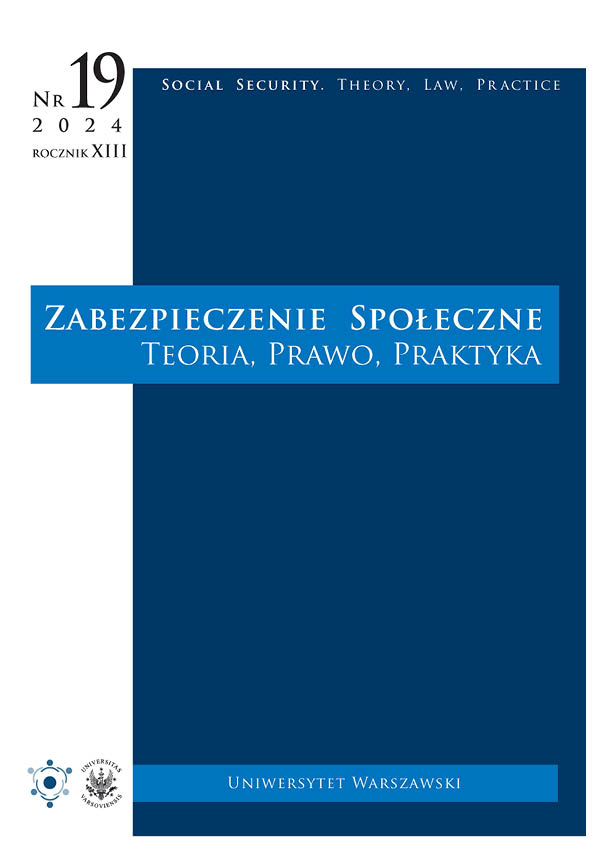Factors shaping the length of sick leave of Polish pregnant women during the Covid-19 pandemic in the light of a survey study
https://doi.org/10.31971/2299-2332.2024.19.4
Keywords:
: cause of absence, sick leave, pregnancy, survey, Social Insurance InstitutionAbstract
For at least a decade, Polish researchers have been drawing attention to the important problem of women’s absence due to pregnancy complications and maternal diseases during pregnancy. The use of sick leave during pregnancy is very common in Poland. In 2021, more than half (52%) of women were on sick leave with code B for at least 6 months. As a result, pregnancy is the most common cause of absence among Poles if the number of absence days is taken as an indicator (16.5% of the total number of absence days). Looking at women themselves, the scale of being on sick leave during pregnancy appears to be even more serious – 30% of women’s sick days in 2021 were due to incapacity during pregnancy. It is therefore appropriate to carry out studies aimed at identifying the causes of the incapacity of pregnant women for work. The article presents the results of a survey conducted in 2023 on a representative nationwide sample of 1000 women aged between 25 and 40 years. The group of respondents and the declared reasons for using sick leave during pregnancy were characterized. Factors that have a significant impact on the duration of the use of this exemption have been identified. As a result of the analyses, they were divided into two main groups: health and occupational. The importance of individual factors on shaping the length of sick leave during pregnancy among Polish women was presented.
References
Ariansen, Anja, MS, Arnstein Mykletun. “Does postponement of first pregnancy increase gender differences in sickness absence? A register based analysis of Norwegian employees in 1993–2007”. PLoS One 9(3) (2014). 9:e93006.https://doi.org/10.1371/journal.pone.0093006.
Bartkowski, J. „Analiza absencji chorobowej w pracy na podstawie danych GUS i ZUS”. W: Absencja chorobowa w Polsce, red. Ewa Giermanowska, Mariola Racław-Markowska, Mariola, 71–72. Warszawa: Instytut Spraw Publicznych, 2004.
Dørheim, Signe K., Bjørn Bjorvatn, Malin Eberhard-Gran. “Sick leave during pregnancy: a longitudinal study of rates and risk factors in a Norwegian population”. BJOG: an international journal of obstetrics and gynaecology 120(5) 2013: 521–530. https://doi.org/10.1111/1471-0528.12035.
GUS. Roczne wskaźniki cen towarów i usług konsumpcyjnych. Warszawa: GUS, 2023. Dostęp 12.11.2023. https://stat.gov.pl/obszary-tematyczne/ceny-handel/wskazniki-cen/wskazniki-cen-towarow-i-uslug-konsumpcyjnych-pot-inflacja-/roczne-wskazniki-cen-towarow-i-uslug-konsumpcyjnych/.
Hansen, Mette Lausten, Aane Marie Thulstrup, Mette Juhl, Jette Kolding Kristensen, Cecilia Høst Ramlau-Hansen. “Predictors of sickness absence in pregnancy: a Danish cohort study”. Scandinavian Journal of Work, Environment and Health 41(2) 2015: 184–193. https://doi.org/10.5271/sjweh.3470.
Indulski, J.A., Z. Szubert. “Medical causes of female sickness absence during economic transition in Poland”. Int. J. Occup. Med. Environ. Health 12(4) (1999): 295.
Kobuszewski, Bartosz, Piotr Winciunas, Jacek Pruszyński, Wojciech Stefan Zgliczyński. “Absencja chorobowa w latach 2019–2020 a działania ZUS na rzecz przeciwdziałania niezdolności do pracy”. Wiedza Medyczna 4 (1) (2022): 33-38. https://doi.org/10.36553/wm.112.
Kristensen, P., R. Nordhagen, E. Wergeland et al. “Job adjustment and absence from work in mid-pregnancy in the Norwegian Mother and Child Cohort Study (MoBa)”. Occupational and environmental medicine 65(8) (2008): 560–566. https://doi.org/10.1136/oem.2007.035626.
Pedersen, Pernille, Merete Labriola, Claus Vinther Nielsen et al. “Systematic review of interventions targeting sickness absence among pregnant women in healthcare settings and workplaces”. BMJ Open 2018, 8:e024032. doi:10.1136/bmjopen-2018-024032.
Scheil-Adlung, Xenia, Lydia Sandner. The case for paid sick leave. World health report 2010. Background Paper, 9. Geneva: WHO, 2010.
Striker, Małgorzata, Ewa Kusideł. “Determinants of Employee Absence Differentiation”. Acta Universitatis Lodziensis. Folia Oeconomica 1(333): 2018, [39]–56. DOI: 10.18778/0208-6018.333.03.
Sydsjö, Gunilla, Adam Sydsjö. “Newly delivered women's evaluation of personal health status and attitudes towards sickness absence and social benefits”. Acta Obstet Gynecol Scand 81 (2002): 104–111. https://doi.org/10.1080/j.1600-0412.2002.810203.x.
Szubert, Zuzanna. „Absencja chorobowa w Polsce po transformacji społeczno-gospodarczej”. Medycyna Pracy 65 (2014): 73.
Uścińska, Gertruda. „Ubezpieczenie chorobowe. Okresowa niezdolność do pracy osób ubezpieczonych w 2022 r.”. Zabezpieczenie Społeczne. Teoria, Prawo, Praktyka 16 (2022): 9–16. DOI: 10.31971/2299-2332.2022.16.
Whittall, Michael. Flexible working environment can reduce absenteeism. Eurofound, 2007. Dostęp. 7.03.2024. https://www.eurofound.europa.eu/en/resources/article/2007/flexible-working-environment-can-reduce-absenteeism.
WHO, International classification of diseases and related health problems: ICD-11. Geneva: WHO, 2022.
ZUS. Absencja chorobowa w 2021 r. Warszawa: ZUS, 2022. Dostęp 12.11.2023. https://www.zus.pl/documents/10182/39590/Absencja+chorobowa_raport_2021.pdf.
ZUS. Absencja chorobowa w 2022 r. Warszawa: ZUS, 2023. Dostęp 12.11.2023. https://www.zus.pl/documents/10182/39590/Absencja+chorobowa_raport_2022.pdf.

Downloads
Published
Issue
Section
License
This article is published under the Creative Commons Attribution 4.0 International (CC BY 4.0) license.
Full license text: https://creativecommons.org/licenses/by/4.0/
The author retains copyright and grants the editorial office a non-exclusive license to publish the article.
